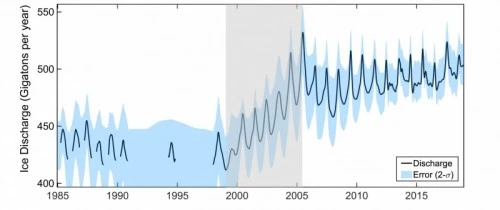The yearly formation and shrinkage of the Greenland ice sheet is a delicate balancing act, with melting glaciers reducing its mass each summer before the snowfall replenishes it in the winter. New analysis of satellite data has revealed that these opposing forces are no longer working in harmony and the ice sheet is now shrinking so much that, even if climate change were to halt tomorrow, it has already passed a point of no return and would continue to shrink for some time.
The dire findings come from a team at the Ohio State University, who drew on nearly 40 years of satellite data to track changes in the Greenland ice sheet. This was made up of monthly data on more than 200 glaciers that drain away into the surrounding oceans, offering the scientists a look at long-term trends around ice loss and reformation through snowfall.
“We’ve been looking at these remote sensing observations to study how ice discharge and accumulation have varied,” says Michalea King, lead author of the study and a researcher at Ohio State University’s Byrd Polar and Climate Research Center. “And what we’ve found is that the ice that’s discharging into the ocean is far surpassing the snow that’s accumulating on the surface of the ice sheet.”
The data revealed that throughout the 80s and 90s, the balance between snowfall and ice loss was more or less sustainable, with the sheet shedding about 450 gigatons each year before regaining it through snowfall. However, the team found that around the turn of the century the ice loss started to pick up, with the glaciers losing around 500 gigatons each year while snowfall remained the same.

This differential over the past 15 to 20 years has now pushed the ice sheet past the point of no return, according to the scientists. They report that the large glaciers have retreated by an average of 3 km (1.86 mi) since 1985, with many of them now sitting in deep water that makes them more susceptible to melting, only compounding the problem.
Prior to 2000, the team says that the ice sheet had a 50-50 chance of either gaining or losing mass each year. In the current conditions, they expect it to gain mass only once in 100 years. Moreover, the researchers say that even if we were to somehow stop the process of climate change today, ice loss would continue to outstrip ice accumulation each year.
“Glacier retreat has knocked the dynamics of the whole ice sheet into a constant state of loss,” says Ian Howat, a co-author on the paper. “Even if the climate were to stay the same or even get a little colder, the ice sheet would still be losing mass.”
The findings are just the latest in a series of grim observations concerning the ice sheet and rising sea levels, of which Greenland’s melting glaciers are a big contributor. One paper published back in April revealed that the Greenland ice sheet lost 600 gigatons of mass in 2019, the biggest drop since records began in 1948. But as King points out, there are positives to come from these findings, in that they help us grasp the true reality of the problem at hand.
“It’s always a positive thing to learn more about glacier environments, because we can only improve our predictions for how rapidly things will change in the future,” she says. “And that can only help us with adaptation and mitigation strategies. The more we know, the better we can prepare.”
The research was published in the journal Communications Earth and Environment.
Source: Ohio State University




